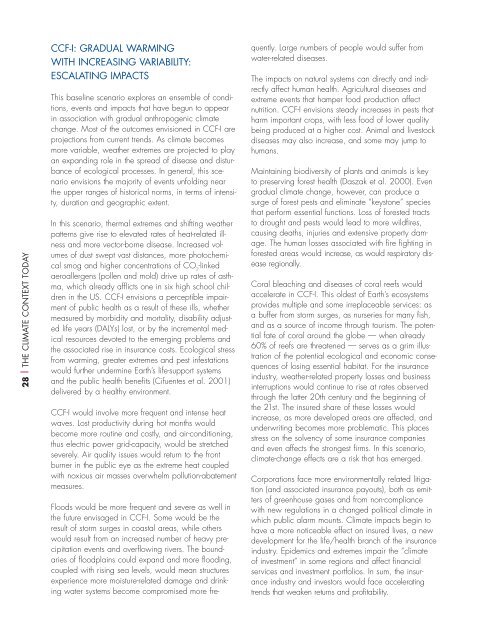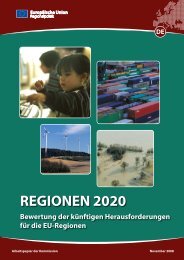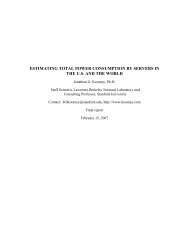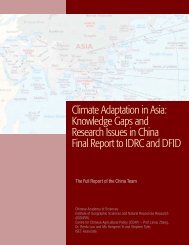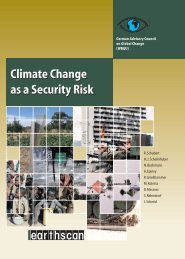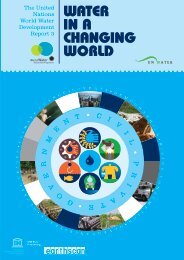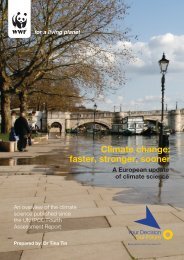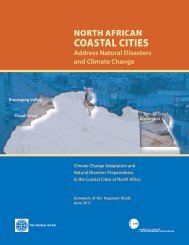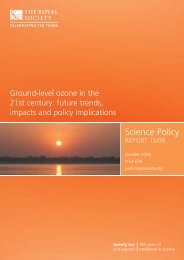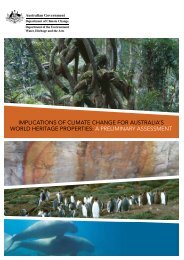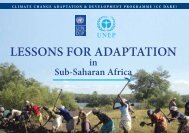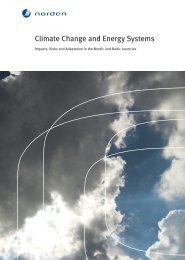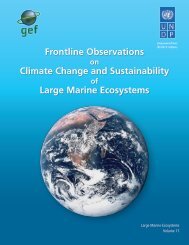• Thawing of permafrost (permanently frozen l<strong>and</strong>)could increase atmospheric concentrations of methane<strong>and</strong> contribute to further global warming.o Methane, while shorter lived than CO 2, is 21times more powerful as a greenhouse gas.CANDIDATES FOR ABRUPT CLIMATE CHANGE• Slippage of a large portion of Greenl<strong>and</strong> or theWAIS would raise sea levels many feet, inundatingcoastal settlements throughout the world.o Loss of all of Greenl<strong>and</strong> or the WAIS (unlikely tooccur for centuries) would each raise sea levels7 meters (21 feet).• Release of methane from thawing Arctic <strong>and</strong> borealpermafrost could suddenly force the climate into amuch warmer state (Stokstad 2004).o The world’s largest frozen peat bog — a permafrostregion the size of France <strong>and</strong> Germanycombined, spanning the entire sub-Arctic region ofwestern Siberia — has begun to melt for the firsttime since forming 11,000 years ago at the endof the last ice age (Pearce 2005). The Alaskantundra is also thawing.o Western Siberia has warmed an average of 3°C(5.4°F) in the last 40 years, faster than almost anywhereelse on Earth. The west Siberian bog containssome 70 billion tons of methane, a quarter ofall the methane stored on the earth’s l<strong>and</strong> surface(Pearce 2005).• Changes in the North Atlantic (ice melting <strong>and</strong> rainfalling) could shut down the Gulf Stream <strong>and</strong> theocean conveyor belt, triggering a “cold reversal” thatalters climate in the Northern Hemisphere <strong>and</strong> theMiddle East (NAS 2002; ACIA 2005).o The global impacts of such a shutdown might betempered by overall global warming.• There may be a threshold level or “tipping point” forEarth’s total reflectivity (albedo).o The Earth’s overall albedo is now about 30%. Ifenough ice melts <strong>and</strong> Earth’s albedo decreases to28%, for instance, the increased heat entering theoceans could potentially trigger a “runaway warming,”with accelerated heating of Earth’s surface.(Rignot <strong>and</strong> Thomas 2002; Rignot et al. 2004;Cook et al. 2005).The instabilities underlying the potential “tippingpoints” are all present today — <strong>and</strong> they are notoccurring in isolation. Several of the <strong>change</strong>s depictedcould occur concurrently. Significant discharges of ice,for example, could be accompanied by large releasesof methane. As modelers grapple with the potential forstep-wise <strong>change</strong>s in the climate system (Schellnhuber2002), the potential for multiple, linked abrupt<strong>change</strong>s to occur makes the outcomes <strong>and</strong> impacts ofaccelerated <strong>change</strong> all the more uncertain.Management, adaptation <strong>and</strong> mitigation strategies thatunderestimate the potential for exponential <strong>change</strong> inbiological systems or abrupt <strong>change</strong> in climate areunlikely to be successful. Substantially reducing greenhousegas emissions to stabilize the concentrationscould slow the rate of climate <strong>change</strong> <strong>and</strong> give thesystem the chance to reach a new equilibrium.THE CLIMATE CHANGEFUTURES SCENARIOSIn order to envision the future impacts of climate<strong>change</strong>, this study considers the potential for warmingto proceed gradually, but with growing variance inweather. Both scenarios envision a climate context ofgradual warming with growing variability <strong>and</strong> moreweather extremes. Both scenarios are based on “business-as-usual,”a scenario which, if unabated, wouldlead to doubling of CO 2from pre-industrial values bymidcentury. Extensive case studies described in Part IIof this report provide background on the various classesof impacts. The first scenario calls for escalatingimpacts, <strong>and</strong> this assessment examines the <strong>economic</strong><strong>dimensions</strong> of <strong>health</strong> <strong>and</strong> environmental impacts. Thesecond scenario envisions a future with widespread,abrupt impacts. Note that these two scenarios areabout the potential impacts of climate <strong>change</strong>, not thetypes of climate shocks or abrupt <strong>change</strong>s depictedabove. The first scenario implies grave consequencesfor the global economy, while the widespread impactsof the second would be devastating <strong>and</strong> most likelyunmanageable.Regarding the worst-case scenario, the interested readermay refer to the “Pentagon Scenario” (Schwartz<strong>and</strong> R<strong>and</strong>all 2003) on abrupt climate <strong>change</strong>, whichforces the reader to “think the unthinkable.”27 | THE CLIMATE CONTEXT TODAY
28 | THE CLIMATE CONTEXT TODAYCCF-I: GRADUAL WARMINGWITH INCREASING VARIABILITY:ESCALATING IMPACTSThis baseline scenario explores an ensemble of conditions,events <strong>and</strong> impacts that have begun to appearin association with gradual anthropogenic climate<strong>change</strong>. Most of the outcomes envisioned in CCF-I areprojections from current trends. As climate becomesmore variable, weather extremes are projected to playan exp<strong>and</strong>ing role in the spread of disease <strong>and</strong> disturbanceof <strong>ecological</strong> processes. In general, this scenarioenvisions the majority of events unfolding nearthe upper ranges of historical norms, in terms of intensity,duration <strong>and</strong> geographic extent.In this scenario, thermal extremes <strong>and</strong> shifting weatherpatterns give rise to elevated rates of heat-related illness<strong>and</strong> more vector-borne disease. Increased volumesof dust swept vast distances, more photochemicalsmog <strong>and</strong> higher concentrations of CO 2-linkedaeroallergens (pollen <strong>and</strong> mold) drive up rates of asthma,which already afflicts one in six high school childrenin the US. CCF-I envisions a perceptible impairmentof public <strong>health</strong> as a result of these ills, whethermeasured by morbidity <strong>and</strong> mortality, disability adjustedlife years (DALYs) lost, or by the incremental medicalresources devoted to the emerging problems <strong>and</strong>the associated rise in insurance costs. Ecological stressfrom warming, greater extremes <strong>and</strong> pest infestationswould further undermine Earth’s life-support systems<strong>and</strong> the public <strong>health</strong> benefits (Cifuentes et al. 2001)delivered by a <strong>health</strong>y environment.CCF-I would involve more frequent <strong>and</strong> intense heatwaves. Lost productivity during hot months wouldbecome more routine <strong>and</strong> costly, <strong>and</strong> air-conditioning,thus electric power grid-capacity, would be stretchedseverely. Air quality issues would return to the frontburner in the public eye as the extreme heat coupledwith noxious air masses overwhelm pollution-abatementmeasures.Floods would be more frequent <strong>and</strong> severe as well inthe future envisaged in CCF-I. Some would be theresult of storm surges in coastal areas, while otherswould result from an increased number of heavy precipitationevents <strong>and</strong> overflowing rivers. The boundariesof floodplains could exp<strong>and</strong> <strong>and</strong> more flooding,coupled with rising sea levels, would mean structuresexperience more moisture-related damage <strong>and</strong> drinkingwater systems become compromised more frequently.Large numbers of people would suffer fromwater-related diseases.The impacts on natural systems can directly <strong>and</strong> indirectlyaffect human <strong>health</strong>. Agricultural diseases <strong>and</strong>extreme events that hamper food production affectnutrition. CCF-I envisions steady increases in pests thatharm important crops, with less food of lower qualitybeing produced at a higher cost. Animal <strong>and</strong> livestockdiseases may also increase, <strong>and</strong> some may jump tohumans.Maintaining biodiversity of plants <strong>and</strong> animals is keyto preserving forest <strong>health</strong> (Daszak et al. 2000). Evengradual climate <strong>change</strong>, however, can produce asurge of forest pests <strong>and</strong> eliminate “keystone” speciesthat perform essential functions. Loss of forested tractsto drought <strong>and</strong> pests would lead to more wildfires,causing deaths, injuries <strong>and</strong> extensive property damage.The human losses associated with fire fighting inforested areas would increase, as would respiratory diseaseregionally.Coral bleaching <strong>and</strong> diseases of coral reefs wouldaccelerate in CCF-I. This oldest of Earth’s ecosystemsprovides multiple <strong>and</strong> some irreplaceable services: asa buffer from storm surges, as nurseries for many fish,<strong>and</strong> as a source of income through tourism. The potentialfate of coral around the globe — when already60% of reefs are threatened — serves as a grim illustrationof the potential <strong>ecological</strong> <strong>and</strong> <strong>economic</strong> consequencesof losing essential habitat. For the insuranceindustry, weather-related property losses <strong>and</strong> businessinterruptions would continue to rise at rates observedthrough the latter 20th century <strong>and</strong> the beginning ofthe 21st. The insured share of these losses wouldincrease, as more developed areas are affected, <strong>and</strong>underwriting becomes more problematic. This placesstress on the solvency of some insurance companies<strong>and</strong> even affects the strongest firms. In this scenario,climate-<strong>change</strong> effects are a risk that has emerged.Corporations face more environmentally related litigation(<strong>and</strong> associated insurance payouts), both as emittersof greenhouse gases <strong>and</strong> from non-compliancewith new regulations in a <strong>change</strong>d political climate inwhich public alarm mounts. <strong>Climate</strong> impacts begin tohave a more noticeable effect on insured lives, a newdevelopment for the life/<strong>health</strong> branch of the insuranceindustry. Epidemics <strong>and</strong> extremes impair the “climateof investment” in some regions <strong>and</strong> affect financialservices <strong>and</strong> investment portfolios. In sum, the insuranceindustry <strong>and</strong> investors would face acceleratingtrends that weaken returns <strong>and</strong> profitability.
- Page 1 and 2: Climate Change FuturesHealth, Ecolo
- Page 4 and 5: Table of ContentsIntroductionPart I
- Page 6 and 7: EXECUTIVE SUMMARYClimate is the con
- Page 8 and 9: the past decade, an increasing prop
- Page 10 and 11: THE CASE STUDIES IN BRIEFInfectious
- Page 12 and 13: THE INSURER’S OVERVIEW:A UNIQUE P
- Page 14: Regulators and governments can empl
- Page 17 and 18: THE PROBLEM:CLIMATE IS CHANGING, FA
- Page 19 and 20: Figure 1.3 GreenlandEXTREMESOne of
- Page 21 and 22: 20 | THE CLIMATE CONTEXT TODAYWholl
- Page 23 and 24: Figure 1.5 Global Weather-Related L
- Page 25 and 26: Climate signals in rising costs fro
- Page 27: CLIMATE CHANGE CANOCCUR ABRUPTLYPer
- Page 31 and 32: communities, salinizing ground wate
- Page 33 and 34: Health is the final common pathway
- Page 35 and 36: 34 | INFECTIOUS AND RESPIRATORY DIS
- Page 37 and 38: Figure 2.4 Malaria and Floods in Mo
- Page 39 and 40: Figure 2.61920-1980CASE STUDIES38 |
- Page 41 and 42: A MALARIA SUCCESSThe New York Times
- Page 43 and 44: A new flavivirus, Usutu, akin to WN
- Page 45 and 46: 44 | INFECTIOUS AND RESPIRATORY DIS
- Page 47 and 48: One analysis (Vanderhoof and Vander
- Page 49 and 50: BIODIVERSITYBUFFERS AGAINSTTHE SPRE
- Page 51 and 52: Figure 2.15 RagweedMOLDSLong-term f
- Page 53 and 54: ASTHMA COSTSTODAYexamples, the Afri
- Page 55 and 56: Stott et al. (2004) calculate that
- Page 57 and 58: In the summer of 2005, northern Spa
- Page 59 and 60: a better understanding of subpopula
- Page 61 and 62: 60 | EXTREME WEATHER EVENTSFLOODSFO
- Page 63 and 64: MOSQUITO- AND SOIL-BORNE DISEASESEC
- Page 65 and 66: Table 2.2 Direct and Indirect Healt
- Page 67 and 68: HEALTH AND ECOLOGICALIMPLICATIONSOu
- Page 69 and 70: 68 | NATURAL AND MANAGED SYSTEMSCAS
- Page 71 and 72: Figure 2.27 Soybean Sudden Death Sy
- Page 73 and 74: 72 | NATURAL AND MANAGED SYSTEMSCAS
- Page 75 and 76: 74 | NATURAL AND MANAGED SYSTEMSCAS
- Page 77 and 78: 76 | NATURAL AND MANAGED SYSTEMSCAS
- Page 79 and 80:
78 | NATURAL AND MANAGED SYSTEMSTHE
- Page 81 and 82:
HARMFUL ALGALBLOOMSFigure 2.32 Red
- Page 83 and 84:
82 | NATURAL AND MANAGED SYSTEMSCAS
- Page 85 and 86:
CASE STUDIES 84 | NATURAL AND MANAG
- Page 87 and 88:
CASE STUDIES 86 | NATURAL AND MANAG
- Page 89 and 90:
CASE STUDIES 88 | NATURAL AND MANAG
- Page 91 and 92:
CASE STUDIES 90 | NATURAL AND MANAG
- Page 93 and 94:
“Climate change is one of the wor
- Page 95 and 96:
94 | FINANCIAL IMPLICATIONS• Incr
- Page 97 and 98:
Extreme weather events are a partic
- Page 99 and 100:
98 | FINANCIAL IMPLICATIONSTable 3.
- Page 101 and 102:
100 | FINANCIAL IMPLICATIONSdemand
- Page 103 and 104:
102 | FINANCIAL IMPLICATIONSClimate
- Page 105 and 106:
These include:Solar Photovoltaic Pa
- Page 107 and 108:
• Social and economic factors in
- Page 109 and 110:
Finally, new technologies need to b
- Page 111 and 112:
110 | FINANCIAL IMPLICATIONSBRETTON
- Page 113:
112 | APPENDICESAppendix A. Summary
- Page 116 and 117:
Table B.1 Summer Percentage Frequen
- Page 118 and 119:
Climate sensitivity for small-scale
- Page 120 and 121:
diffuse and do not manifest in sing
- Page 122 and 123:
APPENDIX D.LIST OF PARTICIPANTS ATT
- Page 124:
Carmenza RobledoGruppe OekologieEMP
- Page 127 and 128:
126 | BIBLIOGRAPHYBibliographyAAAAI
- Page 129 and 130:
128 | BIBLIOGRAPHYChordas, L. Epide
- Page 131 and 132:
Ford, S.E. & Tripp, M.R. Diseases a
- Page 133 and 134:
132 | BIBLIOGRAPHYKalkstein, L. S.,
- Page 135 and 136:
134 | BIBLIOGRAPHYMills, E. The ins
- Page 137 and 138:
136 | BIBLIOGRAPHYRose, J. B., Epst
- Page 139 and 140:
138 | BIBLIOGRAPHYVandyk, J. K., Ba
- Page 142:
Infectious and Respiratory Diseases


